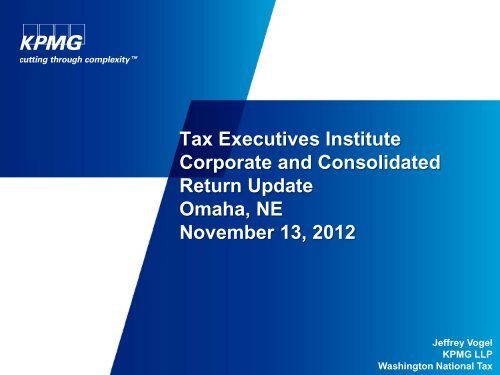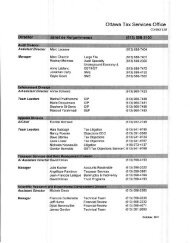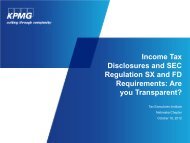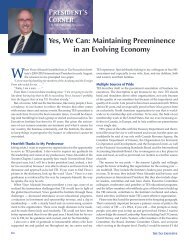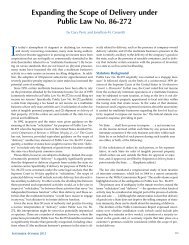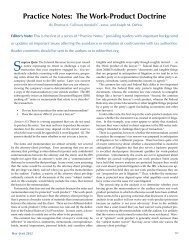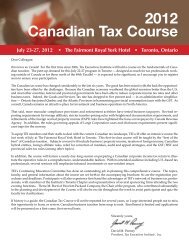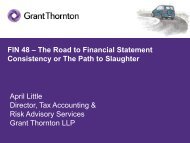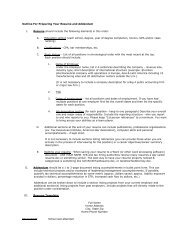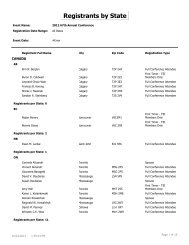KPMG PPT - Tax Executives Institute, Inc.
KPMG PPT - Tax Executives Institute, Inc.
KPMG PPT - Tax Executives Institute, Inc.
Create successful ePaper yourself
Turn your PDF publications into a flip-book with our unique Google optimized e-Paper software.
<strong>Tax</strong> <strong>Executives</strong> <strong>Institute</strong><br />
Corporate and Consolidated<br />
Return Update<br />
Omaha, NE<br />
November 13, 2012<br />
Jeffrey Vogel<br />
<strong>KPMG</strong> LLP<br />
Washington National <strong>Tax</strong>
Notice<br />
ANY TAX ADVICE IN THIS COMMUNICATION IS NOT INTENDED<br />
OR WRITTEN BY <strong>KPMG</strong> TO BE USED, AND CANNOT BE USED,<br />
BY A CLIENT OR ANY OTHER PERSON OR ENTITY FOR THE<br />
PURPOSE OF (i) AVOIDING PENALTIES THAT MAY BE IMPOSED<br />
ON ANY TAXPAYER OR (ii) PROMOTING, MARKETING OR<br />
RECOMMENDING TO ANOTHER PARTY ANY MATTERS<br />
ADDRESSED HEREIN.<br />
You (and your employees, representatives, or agents) may disclose to any and all persons, without<br />
limitation, the tax treatment or tax structure, or both, of any transaction described in the associated<br />
materials we provide to you, including, but not limited to, any tax opinions, memoranda, or other tax<br />
analyses contained in those materials.<br />
The information contained herein is of a general nature and based on authorities that are subject to<br />
change. Applicability of the information to specific situations should be determined through<br />
consultation with your tax adviser.<br />
©2012 <strong>KPMG</strong> LLP, a Delaware limited liability partnership and the U.S. member firm of the <strong>KPMG</strong> network of independent member<br />
firms affiliated with <strong>KPMG</strong> International Cooperative (“<strong>KPMG</strong> International”), a Swiss entity. All rights reserved.<br />
2
Built-in Loss on<br />
Subsidiary Stock<br />
© 2011 <strong>KPMG</strong> LLP, a Delaware limited liability partnership and the U.S. member firm of the <strong>KPMG</strong> network of independent member firms affiliated with<br />
<strong>KPMG</strong> International Cooperative (“<strong>KPMG</strong> International”), a Swiss entity. All rights reserved. Printed in the U.S.A. FOR INTERNAL USE ONLY.
Background<br />
►<br />
Section 332 - No gain or loss will be recognized on the receipt by a<br />
corporation of property distributed in complete liquidation of<br />
another corporation.<br />
►<br />
Section 331 - Amounts received by a shareholder in a distribution<br />
in complete liquidation are treated as in full payment in exchange<br />
for the stock.<br />
©2012 <strong>KPMG</strong> LLP, a Delaware limited liability partnership and the U.S. member firm of the <strong>KPMG</strong> network of independent member<br />
firms affiliated with <strong>KPMG</strong> International Cooperative (“<strong>KPMG</strong> International”), a Swiss entity. All rights reserved.<br />
4
Section 267(f) – Background<br />
P<br />
P<br />
Unrelated Party<br />
100%<br />
(Loss stock)<br />
70%<br />
30%<br />
S<br />
S<br />
► P sells 30 percent of S stock (at a loss) to Unrelated Party. P<br />
recognizes and takes into account the loss on the sold stock.<br />
► S liquidates. Section 331 applies to the liquidation (i.e., P<br />
recognizes and takes into account the loss on its remaining 70<br />
percent of S stock).<br />
► See Granite Trust Co. v. United States, 238 F.2d 670 (1 st Cir. 1956); Commissioner v.<br />
Day & Zimmerman, <strong>Inc</strong>. 151 F.2d 517 (3 rd Cir. 1945).<br />
©2012 <strong>KPMG</strong> LLP, a Delaware limited liability partnership and the U.S. member firm of the <strong>KPMG</strong> network of independent member<br />
firms affiliated with <strong>KPMG</strong> International Cooperative (“<strong>KPMG</strong> International”), a Swiss entity. All rights reserved.<br />
5
Section 267(f) – Background (Cont’d)<br />
►<br />
►<br />
►<br />
Section 267(a)(1) – Disallows loss on sales between related persons (as<br />
defined in § 267(b)). Does not apply to any loss of the distributing corporation<br />
(or the distributee) in the case of a distribution in complete liquidation.<br />
Section 267(f)(2) – Defers losses from sales between members of the same<br />
controlled group to which § 267(a)(1) would otherwise apply, until the loss is<br />
taken into account under consolidated return principles. Losses under § 267(f)<br />
are generally deferred until they are taken into account under the timing<br />
principles of the matching and acceleration rules of Treas. Reg. §§ 1.1502-<br />
13(c) and (d).<br />
The attribute redetermination rules of Treas. Reg. § 1.1502-13(c) generally do<br />
not apply. Treas. Reg. § 1.267(f)-1(c)(2). However, to the extent S’s (the<br />
selling member’s) loss would be redetermined to be a noncapital,<br />
nondeductible amount under the principles of Treas. Reg. § 1.1502-13, the<br />
loss continues to be deferred and is not taken into account until S and B (the<br />
buying member) are no longer in a controlled group relationship.<br />
©2012 <strong>KPMG</strong> LLP, a Delaware limited liability partnership and the U.S. member firm of the <strong>KPMG</strong> network of independent member<br />
firms affiliated with <strong>KPMG</strong> International Cooperative (“<strong>KPMG</strong> International”), a Swiss entity. All rights reserved.<br />
6
Intercompany Sale of Stock at a Loss Followed by a<br />
Section 332 Liquidation<br />
Example 1<br />
P<br />
P<br />
FMV=$100<br />
AB=$130<br />
S<br />
$100<br />
B<br />
Liquidate<br />
S<br />
B<br />
T<br />
T<br />
►<br />
►<br />
Year 1 – S sells the stock of<br />
T to B for $100 (recognizing<br />
a $30 deferred loss)<br />
Year 2 – T liquidates into B<br />
under § 332<br />
► Under Treas. Reg. § 1.1502-<br />
13(c)(6)(i), S’s intercompany<br />
loss is recharacterized as<br />
noncapital, nondeductible<br />
(see Treas. Reg. § 1.1502-<br />
13(f)(7) Ex. (6)(c))<br />
©2012 <strong>KPMG</strong> LLP, a Delaware limited liability partnership and the U.S. member firm of the <strong>KPMG</strong> network of independent member<br />
firms affiliated with <strong>KPMG</strong> International Cooperative (“<strong>KPMG</strong> International”), a Swiss entity. All rights reserved.<br />
7
Intercompany Sale of Stock at a Loss Followed by a<br />
Section 332 Liquidation<br />
Example 2<br />
30% of<br />
T stock<br />
B<br />
B<br />
cash<br />
T Stock:<br />
AB=$100<br />
FMV=$10<br />
S<br />
T<br />
S<br />
70%<br />
30%<br />
T<br />
►<br />
►<br />
►<br />
►<br />
B, S, and T are members of a consolidated group.<br />
S sells 30 percent of the T stock to B for $3 and S’s $27 loss is deferred.<br />
T later liquidates in a § 332 transaction (before any change in the value of<br />
the T stock).<br />
The attribute redetermination rule of Treas. Reg. § 1.1502-13(c)(1)<br />
recharacterizes S’s intercompany loss to produce the same results to the<br />
group as if S and B were divisions of a single corporation. Thus, S’s<br />
intercompany loss is redetermined to be a noncapital, nondeductible<br />
amount.<br />
©2012 <strong>KPMG</strong> LLP, a Delaware limited liability partnership and the U.S. member firm of the <strong>KPMG</strong> network of independent member<br />
firms affiliated with <strong>KPMG</strong> International Cooperative (“<strong>KPMG</strong> International”), a Swiss entity. All rights reserved.<br />
8
Section 267(f) – Final Regulations<br />
►<br />
►<br />
To the extent S's loss would be redetermined to be a noncapital,<br />
nondeductible amount under the principles of Treas. Reg. § 1.1502-13, but is<br />
not redetermined because of Treas. Reg. § 1.267(f)-1(c)(2) (which generally<br />
renders the attribute redetermination rule inapplicable to sales between<br />
members of a controlled group), S’s loss continues to be deferred…If the loss<br />
is deferred, it is taken into account when S and B (including their successors)<br />
are no longer in a controlled group relationship or to the extent of any<br />
corresponding income or gain recognized by B with respect to the property,<br />
whichever occurs first.<br />
For example, if S sells all of the stock of corporation T to B at a loss (in a<br />
transaction that is treated as a sale or exchange for federal income tax<br />
purposes), and T subsequently liquidates in an unrelated transaction that<br />
qualifies under § 332, S’s loss is deferred until S and B are no longer in a<br />
controlled group relationship. Similarly, if S owns all of the T stock, sells 30<br />
percent of T’s stock to B at a loss (in a transaction that is treated as a sale or<br />
exchange for federal income tax purposes), and T subsequently liquidates into<br />
S and B, S's loss on the sale is deferred until S and B (including their<br />
successors) are no longer in a controlled group relationship.<br />
©2012 <strong>KPMG</strong> LLP, a Delaware limited liability partnership and the U.S. member firm of the <strong>KPMG</strong> network of independent member<br />
firms affiliated with <strong>KPMG</strong> International Cooperative (“<strong>KPMG</strong> International”), a Swiss entity. All rights reserved.<br />
9
Section 267(f) – Final Regulations (Cont’d)<br />
►<br />
►<br />
►<br />
If B recognizes any income or gain on amounts received in a<br />
distribution in complete liquidation of T, S will take into account its<br />
deferred loss on its sale of T stock to the extent of B’s gain.<br />
For purposes of applying Treas. Reg. § 1.267(f)-1(c)(1)(iv), stock<br />
held by S, stock held by B, and stock held by all members of S’s<br />
consolidated group as well as stock held by any member of a<br />
controlled group of which S is a member that was acquired from a<br />
member of S's consolidated group must be taken into account in<br />
determining whether a loss would be determined to be a noncapital,<br />
nondeductible amount under the principles of Treas. Reg. § 1.1502-<br />
13.<br />
Stock issued to a member of the controlled group is taken into<br />
account for determining whether a loss is treated as noncapital,<br />
nondeductible.<br />
©2012 <strong>KPMG</strong> LLP, a Delaware limited liability partnership and the U.S. member firm of the <strong>KPMG</strong> network of independent member<br />
firms affiliated with <strong>KPMG</strong> International Cooperative (“<strong>KPMG</strong> International”), a Swiss entity. All rights reserved.<br />
10
Section 267(f) – Final Regulations Example 3<br />
30% of<br />
T stock<br />
T Stock:<br />
AB=$100<br />
FMV=$10<br />
►<br />
►<br />
B<br />
(Foreign)<br />
S<br />
T<br />
cash<br />
B is foreign. S and T are<br />
members of a consolidated<br />
group.<br />
S sells 30 percent of the T stock<br />
to B for $3 and S’s $27 loss is<br />
deferred under § 267(f).<br />
►<br />
►<br />
►<br />
S<br />
70%<br />
B<br />
(Foreign)<br />
30%<br />
T later liquidates in a taxable transaction<br />
(before any change in the value of the T<br />
stock).<br />
S’s $27 loss continues to be deferred until S<br />
and B (and their successors) are no longer<br />
in a controlled group relationship.<br />
Compare PLR 200812006 (deferred loss is<br />
taken into account at the time of the section<br />
331 liquidation) to PLR 201014002, ILM<br />
201025046, and CCA 200931043 (deferred<br />
loss remains deferred).<br />
T<br />
©2012 <strong>KPMG</strong> LLP, a Delaware limited liability partnership and the U.S. member firm of the <strong>KPMG</strong> network of independent member<br />
firms affiliated with <strong>KPMG</strong> International Cooperative (“<strong>KPMG</strong> International”), a Swiss entity. All rights reserved.<br />
11
Section 267(f) – Final Regulations Example 4<br />
10% of<br />
T stock<br />
B<br />
(Foreign)<br />
B<br />
(Foreign)<br />
S<br />
50%<br />
S<br />
60%<br />
T Stock:<br />
(aggregate)<br />
AB=$100<br />
FMV=$10<br />
50%<br />
T<br />
40%<br />
T<br />
•<br />
►<br />
►<br />
B is foreign. T is solvent.<br />
S sells 10 percent of the T stock<br />
to B for $1. S’s $9 loss is<br />
deferred under § 267(f).<br />
►<br />
►<br />
T liquidates in a taxable<br />
transaction.<br />
Under the final regulations, S’s<br />
$9 loss continues to be deferred<br />
until S and B (and their<br />
successors) are no longer in a<br />
controlled group relationship.<br />
©2012 <strong>KPMG</strong> LLP, a Delaware limited liability partnership and the U.S. member firm of the <strong>KPMG</strong> network of independent member<br />
firms affiliated with <strong>KPMG</strong> International Cooperative (“<strong>KPMG</strong> International”), a Swiss entity. All rights reserved.<br />
12
Worthless Stock Loss<br />
Requirements for a Capital Loss (§ 165(g)(1))<br />
►<br />
A corporation may claim a capital loss with respect to the stock of a<br />
subsidiary (“Loss Co”) under §165(g)(1) if:<br />
– Loss Co’s stock is “worthless” in the tax year that the loss is claimed<br />
– To establish worthlessness, Loss Co must:<br />
» Have had value (liquidating or potential) at some point during the tax<br />
year, but by year end have no liquidating value (i.e., liabilities > FMV<br />
of assets) and no potential value, (with the lack of potential value<br />
generally indicated by an “identifiable event” such as a liquidation),<br />
and,<br />
» If Loss Co is a consolidated subsidiary, meet the consolidated return<br />
timing standards under Treas. Reg. § 1.1502-80(c)<br />
©2012 <strong>KPMG</strong> LLP, a Delaware limited liability partnership and the U.S. member firm of the <strong>KPMG</strong> network of independent member<br />
firms affiliated with <strong>KPMG</strong> International Cooperative (“<strong>KPMG</strong> International”), a Swiss entity. All rights reserved.<br />
13
Worthless Stock Loss<br />
Requirements for an Ordinary Loss (§ 165(g)(3))<br />
►<br />
A domestic corporation may claim an ordinary loss with respect to the<br />
stock of Loss Co under §165(g)(3) if:<br />
– Worthlessness is established for Loss Co’s stock (i.e., the same test as under<br />
§165(g)(1));<br />
– Loss Co is “affiliated” with shareholder (i.e., shareholder must directly own Loss<br />
Co stock that has at least 80% of the total voting power and at least 80% of the<br />
total value of Loss Co); AND<br />
– More than 90% of Loss Co’s aggregate “gross receipts” are from sources other<br />
than royalties, rents, dividends, interest, annuities, and gains from the<br />
disposition of stocks or securities (i.e., passive income)<br />
►<br />
Note that the amount of the worthless stock loss for a consolidated<br />
subsidiary is subject to the unified loss rule under Treas. Reg. § 1.1502-<br />
36<br />
©2012 <strong>KPMG</strong> LLP, a Delaware limited liability partnership and the U.S. member firm of the <strong>KPMG</strong> network of independent member<br />
firms affiliated with <strong>KPMG</strong> International Cooperative (“<strong>KPMG</strong> International”), a Swiss entity. All rights reserved.<br />
14
PLR 201149015<br />
HC2<br />
HC1<br />
S1 S2 S3 HC2<br />
P3<br />
HC1<br />
HC2<br />
P<br />
HC1<br />
HC2<br />
S1 S2 S3<br />
S1<br />
S2<br />
S1<br />
Subs<br />
Simplified Facts:<br />
► P, the common parent of a group, owned HC1, HC1 owned HC2, and HC2 owned S1<br />
and other domestic subsidiaries, and they joined in a consolidated return.<br />
► These corporations evolved through prior consolidated groups (as depicted above).<br />
► During its existence, HC2 entered into four types of intercompany transactions in the<br />
various consolidated groups:<br />
– S1 and S2 made § 301(c)(1) distributions to HC2, in cash, property and workforce.<br />
– HC2 provided management services to S1, S2 and S3 for a fee.<br />
– S1 sold certain furniture and fixtures to HC2.<br />
► When S1's last significant asset became worthless, and S1 could not service its<br />
remaining clients, both HC2 and S1 were insolvent, and they dissolved under state law.<br />
©2012 <strong>KPMG</strong> LLP, a Delaware limited liability partnership and the U.S. member firm of the <strong>KPMG</strong> network of independent member<br />
firms affiliated with <strong>KPMG</strong> International Cooperative (“<strong>KPMG</strong> International”), a Swiss entity. All rights reserved.<br />
15
PLR 201149015<br />
HC2<br />
HC1<br />
S1 S2 S3 HC2<br />
P3<br />
HC1<br />
HC2<br />
P<br />
HC1<br />
HC2<br />
S1 S2 S3<br />
S1<br />
S2<br />
S1<br />
Subs<br />
Rulings:<br />
► “Provided that the requirements of § 165(g) (taking into account the provisions of [Treas. Reg. §1.1502-80(c)]) are<br />
satisfied, [HC1 may claim a worthless stock deduction under § 165(g)(3) upon the dissolution of [HC2], subject to the<br />
application of [Treas. Reg. §1.1502-36].”<br />
► “For purposes of the § 165(g)(3)(B) ‘gross receipts’ test, [HC2] will include in its aggregate gross receipts all amounts<br />
of gross receipts received in intercompany transactions that are described in [Treas. Reg. §1.1502-13] (as<br />
effective/applicable on or after July 12, 1995) (‘Intercompany Transactions’), and such amounts from Intercompany<br />
Transactions will be treated as ‘gross receipts from passive sources’ to the extent they are attributable to the<br />
Intercompany Transactions’ counterparty’s ‘gross receipts from passive sources’ (‘Look-Through Approach’). See<br />
[Treas. Reg. §1.1502-13(a), (b) and (c)] (as effective/applicable on or after July 12, 1995).”<br />
► “For purposes of computing [HC2’s] ‘gross receipts’ under § 165(g)(3)(B), [HC2] will take into account the historic<br />
gross receipts of any transferor corporation in a transaction to which § 381(a) applied, provided, however, that [HC2]<br />
will eliminate gross receipts from Intercompany Transactions with any such transferor corporation, as appropriate, to<br />
prevent duplication.”<br />
©2012 <strong>KPMG</strong> LLP, a Delaware limited liability partnership and the U.S. member firm of the <strong>KPMG</strong> network of independent member<br />
firms affiliated with <strong>KPMG</strong> International Cooperative (“<strong>KPMG</strong> International”), a Swiss entity. All rights reserved.<br />
16
PLR 201149015<br />
HC2<br />
HC1<br />
S1 S2 S3 HC2<br />
P3<br />
HC1<br />
HC2<br />
P<br />
HC1<br />
HC2<br />
S1 S2 S3<br />
S1<br />
S2<br />
S1<br />
Subs<br />
Rulings:<br />
► “In applying the Look-Through Approach, for purposes of computing the ‘gross receipts from passive<br />
sources’ of [HC2’s] counterparty in an Intercompany Transaction or any other counterparties in<br />
Intercompany Transactions, the counterparty will include in its aggregate gross receipts all amounts<br />
of gross receipts it received in Intercompany Transactions, and such amounts from Intercompany<br />
Transactions will be treated as ‘gross receipts from passive sources’ to the extent they are<br />
attributable to its counterparty's ‘gross receipts from passive sources.’ In other words, [HC2’s] ‘gross<br />
receipts from passive sources’ is determined by looking at all of [HC2’s] gross receipts from<br />
Intercompany Transactions (even if on its face the Intercompany Transaction appears not to be<br />
"gross receipts from passive sources") and sourcing the gross receipts based on [HC2’s]<br />
counterparty's ‘gross receipts from passive sources.’ Furthermore, [HC2’s] counterparty in<br />
Intercompany Transactions (and [HC2’s] counterparty’s counterparty, and so on until it reaches an<br />
ultimate counterparty) will apply a similar rule.”<br />
©2012 <strong>KPMG</strong> LLP, a Delaware limited liability partnership and the U.S. member firm of the <strong>KPMG</strong> network of independent member<br />
firms affiliated with <strong>KPMG</strong> International Cooperative (“<strong>KPMG</strong> International”), a Swiss entity. All rights reserved.<br />
17
GLAM 2012-006<br />
Basic Facts<br />
Asset 1<br />
$10 Loan to S<br />
AB $10 P<br />
FMV $10 $5<br />
AB $5<br />
FMV $5<br />
S1<br />
AB $10<br />
S<br />
$5<br />
Unwanted<br />
Asset<br />
Wanted Intangible Unwanted Asset<br />
(amortizable)<br />
AB $0 AB $5<br />
FMV $15 FMV $5<br />
►P is the common parent of a consolidated group that includes S1<br />
►On Jan. 1, Year 1, P purchases all of the stock of S for $10<br />
►On Feb. 1, Year 1, S sells Unwanted Asset for $5 and distributes the $5 to P<br />
©2012 <strong>KPMG</strong> LLP, a Delaware limited liability partnership and the U.S. member firm of the <strong>KPMG</strong> network of independent member<br />
firms affiliated with <strong>KPMG</strong> International Cooperative (“<strong>KPMG</strong> International”), a Swiss entity. All rights reserved.<br />
18
GLAM 2012-006<br />
Situation 1<br />
P<br />
$10 debt<br />
Wanted Intangible<br />
P<br />
$10 debt<br />
AB $5<br />
AB $10<br />
AB $5<br />
S1<br />
S<br />
S1<br />
S<br />
WI<br />
Wanted Intangible<br />
AB $0<br />
FMV $15<br />
►On Dec. 31, Year 1, S elects to be disregarded as an entity separate from P<br />
►On the consolidated tax return for Year 1, P claims a worthless stock deduction with respect to<br />
its equity ownership in S<br />
©2012 <strong>KPMG</strong> LLP, a Delaware limited liability partnership and the U.S. member firm of the <strong>KPMG</strong> network of independent member<br />
firms affiliated with <strong>KPMG</strong> International Cooperative (“<strong>KPMG</strong> International”), a Swiss entity. All rights reserved.<br />
19
GLAM 2012-006<br />
Situation 2<br />
AB $5<br />
P<br />
$10 debt<br />
AB $10<br />
Wanted Intangible<br />
AB $5<br />
P<br />
WI<br />
$10 debt<br />
S1<br />
S<br />
S1<br />
S<br />
►On December 31, Year 1, S elects to be disregarded as an entity separate from P<br />
►On the consolidated tax return for Year 1, P claims a worthless stock deduction with respect to<br />
its equity ownership in S<br />
©2012 <strong>KPMG</strong> LLP, a Delaware limited liability partnership and the U.S. member firm of the <strong>KPMG</strong> network of independent member<br />
firms affiliated with <strong>KPMG</strong> International Cooperative (“<strong>KPMG</strong> International”), a Swiss entity. All rights reserved.<br />
20
GLAM 2012-006<br />
Situation 3<br />
P<br />
$10 debt<br />
P<br />
AB $5<br />
AB $10<br />
S1<br />
WI<br />
S<br />
S1<br />
S<br />
Wanted Intangible<br />
►On May 14, Year 2, S transfers Wanted Intangible to S1 in exchange for no consideration and P<br />
cancels S’s liability; the transfer is not reported on the consolidated return<br />
►On December 31, Year 2, S elects to be disregarded as an entity separate from P<br />
►On the consolidated tax return for Year 2, P claims a worthless stock deduction with respect to<br />
its equity ownership in S<br />
©2012 <strong>KPMG</strong> LLP, a Delaware limited liability partnership and the U.S. member firm of the <strong>KPMG</strong> network of independent member<br />
firms affiliated with <strong>KPMG</strong> International Cooperative (“<strong>KPMG</strong> International”), a Swiss entity. All rights reserved.<br />
21
GLAM 2012-006<br />
Situation 4<br />
Asset 1<br />
AB $10<br />
FMV $10<br />
AB $5<br />
P<br />
$10 debt<br />
AB $10<br />
AB $5<br />
P<br />
$10 debt<br />
AB $5<br />
$15<br />
S Stock<br />
Unrelated<br />
S1<br />
S<br />
Asset 1<br />
S1<br />
WI<br />
S<br />
A1<br />
Wanted Intangible<br />
► On May 1, Year 1, P contributes Asset 1 to S<br />
► On Jan. 1, Year 2, S transfers Wanted Intangible to S1 for no consideration; the transfer is not reported on<br />
the consolidated return<br />
► On Jan. 1, Year 7, P sells S to an unrelated person for $15; the group’s consolidated returns do not include<br />
any amortization deduction for S1 with respect to Wanted Intangible or any income for S with respect to<br />
the transfer of Wanted Intangible<br />
©2012 <strong>KPMG</strong> LLP, a Delaware limited liability partnership and the U.S. member firm of the <strong>KPMG</strong> network of independent member<br />
firms affiliated with <strong>KPMG</strong> International Cooperative (“<strong>KPMG</strong> International”), a Swiss entity. All rights reserved.<br />
22
GLAM 2012-003<br />
M<br />
Year 1 Year 2 Year 3<br />
$0 $0 $0<br />
S1<br />
$100 $100 ($200)<br />
CTI/(CNOL) $100 $100 ($200)<br />
Simplified Facts:<br />
► M is a holding company and the common parent of a consolidated group that includes S1.<br />
► The M group incurred a CNOL attributable to S1, and had CTI in the two prior years.<br />
► S1 ceased operations, disposed of its operating assets, and used the proceeds to satisfy certain of<br />
its liabilities, but S1 retained certain assets, including (i) legal claims against directors and officers,<br />
and (ii) an interest in the M group's carryback refund claims.<br />
► The FMV of the retained assets is less than S1's remaining liabilities, and S1 was worthless under §<br />
165(g), without taking into account Treas. Reg. §1.1502-80(c).<br />
Conclusion:<br />
► “A tax refund or other legal claim constitutes an asset in the hands of the subsidiary. Therefore, to<br />
the extent that the value of that claim exceeds state law minimum capital requirements, the stock<br />
cannot meet the requirements for worthlessness under [Treas. Reg. § -19(c)(1)(iii)(A)].”<br />
©2012 <strong>KPMG</strong> LLP, a Delaware limited liability partnership and the U.S. member firm of the <strong>KPMG</strong> network of independent member<br />
firms affiliated with <strong>KPMG</strong> International Cooperative (“<strong>KPMG</strong> International”), a Swiss entity. All rights reserved.<br />
23
GLAM 2012-003<br />
M<br />
Year 1 Year 2 Year 3<br />
$0 $0 $0<br />
S1<br />
$100 $100 ($200)<br />
CTI/(CNOL) $100 $100 ($200)<br />
Analysis:<br />
► There is CTI in carryback years of the M group, available for offset by the CNOL<br />
attributable to S1.<br />
► S1 is entitled to a portion of the M group's refund (eventually cash proceeds), which<br />
constitutes property.<br />
► S1’s director/officer claims are also property.<br />
► The plain language of Treas. Reg. §1.1502-19(c)(1)(iii)(A) requires disposition of all S1<br />
assets (other than corporate charter and state law minimum capitalization) before its<br />
stock may be treated as worthless.<br />
► The S1 stock cannot be treated as worthless.<br />
©2012 <strong>KPMG</strong> LLP, a Delaware limited liability partnership and the U.S. member firm of the <strong>KPMG</strong> network of independent member<br />
firms affiliated with <strong>KPMG</strong> International Cooperative (“<strong>KPMG</strong> International”), a Swiss entity. All rights reserved.<br />
24
Unified Loss Rules<br />
© 2011 <strong>KPMG</strong> LLP, a Delaware limited liability partnership and the U.S. member firm of the <strong>KPMG</strong> network of independent member firms affiliated with<br />
<strong>KPMG</strong> International Cooperative (“<strong>KPMG</strong> International”), a Swiss entity. All rights reserved. Printed in the U.S.A. FOR INTERNAL USE ONLY.
Unified Loss Rules<br />
Basis<br />
$100<br />
$50<br />
$150<br />
P<br />
S<br />
$100<br />
$(150)<br />
$(50)<br />
FMV $100<br />
> $50<br />
> $100<br />
Basis $50 gain $100<br />
► P purchases S for $100 and they file a C/R<br />
► S owns an asset worth $100 with a tax basis of $50<br />
► S sells the asset for $100 while a member of the P group<br />
► This increases P’s basis in the S stock to $150<br />
► P sells the stock of S for $100 and sustains a $50 loss<br />
©2012 <strong>KPMG</strong> LLP, a Delaware limited liability partnership and the U.S. member firm of the <strong>KPMG</strong> network of independent member<br />
firms affiliated with <strong>KPMG</strong> International Cooperative (“<strong>KPMG</strong> International”), a Swiss entity. All rights reserved.<br />
26
Unified Loss Rules<br />
$100<br />
P<br />
S<br />
FMV $100<br />
Basis $100<br />
$50<br />
$(100)<br />
$(50)<br />
$50<br />
NOL > $50<br />
$50<br />
► P forms S with $100 and they file a C/R<br />
► S sustains a $50 NOL that is not currently utilized in the C/R<br />
or carried back<br />
► P sells S for $50<br />
► The stock loss coupled with S’s $50 carryover is considered<br />
loss duplication<br />
©2012 <strong>KPMG</strong> LLP, a Delaware limited liability partnership and the U.S. member firm of the <strong>KPMG</strong> network of independent member<br />
firms affiliated with <strong>KPMG</strong> International Cooperative (“<strong>KPMG</strong> International”), a Swiss entity. All rights reserved.<br />
27
Unified Loss Rules<br />
In September, 2008, the IRS and Treasury finalized the unified loss<br />
rules under Treas. Reg. §1.1502-36.<br />
► Unified loss rules have three priorities:<br />
►<br />
►<br />
►<br />
Prevent the investment adjustment system from creating noneconomic loss, or<br />
failing to eliminate duplicated loss, when members hold subsidiary stock with<br />
disparate bases;<br />
Prevent the circumvention of General Utilities repeal through the use of the<br />
consolidated return regulations;<br />
Prevent the loss duplication that occurs when an economic loss is reflected in<br />
both a member's basis in subsidiary stock and in the subsidiary's assets or<br />
operations.<br />
©2012 <strong>KPMG</strong> LLP, a Delaware limited liability partnership and the U.S. member firm of the <strong>KPMG</strong> network of independent member<br />
firms affiliated with <strong>KPMG</strong> International Cooperative (“<strong>KPMG</strong> International”), a Swiss entity. All rights reserved.<br />
28
Unified Loss Rules<br />
► Basis redetermination rule:<br />
►<br />
►<br />
Treas. Reg. § 1.1502-36(b);<br />
Adjusts stock basis to prevent the investment adjustment system from creating<br />
noneconomic loss and failing to eliminate duplicated loss.<br />
► Basis reduction rule:<br />
►<br />
►<br />
Treas. Reg. § 1.1502-36(c);<br />
Reduces stock basis to prevent noneconomic losses.<br />
► Attribute reduction rule:<br />
►<br />
►<br />
Treas. Reg. § 1.1502-36(d);<br />
Reduces attributes to prevent the duplication of a loss recognized on, or<br />
preserved in the basis of, transferred stock.<br />
©2012 <strong>KPMG</strong> LLP, a Delaware limited liability partnership and the U.S. member firm of the <strong>KPMG</strong> network of independent member<br />
firms affiliated with <strong>KPMG</strong> International Cooperative (“<strong>KPMG</strong> International”), a Swiss entity. All rights reserved.<br />
29
Unified Loss Rules<br />
Basis Redetermination Rule<br />
► Has no effect on the overall gain or loss on members' basis in<br />
subsidiary stock (e.g., the aggregate basis in all shares remains<br />
unchanged, just reallocated).<br />
► Positive investment adjustments eliminated from the basis of<br />
transferred loss shares (but not below value).<br />
► Negative investment adjustments may be removed from shares that are<br />
not transferred and applied to reduce the loss on the transferred loss<br />
shares.<br />
► Adjustments are generally reallocated and applied:<br />
► First to increase (but not above value) members’ bases in<br />
subsidiary preferred shares.<br />
► Second, remaining adjustments are allocated to members’ common<br />
stock.<br />
©2012 <strong>KPMG</strong> LLP, a Delaware limited liability partnership and the U.S. member firm of the <strong>KPMG</strong> network of independent member<br />
firms affiliated with <strong>KPMG</strong> International Cooperative (“<strong>KPMG</strong> International”), a Swiss entity. All rights reserved.<br />
30
Unified Loss Rules<br />
Basis Redetermination Rule<br />
Basis redetermination rule does not apply if:<br />
► There is no disparity among members’ bases in subsidiary<br />
common stock, and no member owns a share of subsidiary’s<br />
preferred stock with unrecognized gain or loss; or<br />
► All subsidiary shares held by members are transferred to<br />
nonmember(s), become worthless under § 165, or a combination<br />
thereof, in one fully taxable transaction.<br />
► Parent may still elect to apply the basis redetermination rule.<br />
©2012 <strong>KPMG</strong> LLP, a Delaware limited liability partnership and the U.S. member firm of the <strong>KPMG</strong> network of independent member<br />
firms affiliated with <strong>KPMG</strong> International Cooperative (“<strong>KPMG</strong> International”), a Swiss entity. All rights reserved.<br />
31
Unified Loss Rules<br />
Basis Redetermination Rule<br />
Issues arising in connection with the basis redetermination rule:<br />
►<br />
►<br />
►<br />
►<br />
►<br />
►<br />
Additional pressure on maintaining basis records;<br />
Information needed on a block-by-block, year-by-year basis;<br />
For each actually issued block of shares or deemed issued block of<br />
shares (e.g., shares deemed issued as a result of an intragroup<br />
reorganization);<br />
If taxpayer acquired another consolidated group, the taxpayer needs to<br />
know basis information for subsidiary members of that other group;<br />
Consider impact of any intercompany debt recharacterized as equity;<br />
this could create another block and/or class of stock to trace;<br />
Potential need for valuation analysis.<br />
©2012 <strong>KPMG</strong> LLP, a Delaware limited liability partnership and the U.S. member firm of the <strong>KPMG</strong> network of independent member<br />
firms affiliated with <strong>KPMG</strong> International Cooperative (“<strong>KPMG</strong> International”), a Swiss entity. All rights reserved.<br />
32
Unified Loss Rules<br />
Basis Reduction Rule<br />
► Intended to eliminate stock loss that is presumed<br />
noneconomic;<br />
► Only applies if, after the application of the basis<br />
redetermination rule, the transferred share is still<br />
a loss share;<br />
► Does not reduce the basis of a transferred share<br />
below value.<br />
©2012 <strong>KPMG</strong> LLP, a Delaware limited liability partnership and the U.S. member firm of the <strong>KPMG</strong> network of independent member<br />
firms affiliated with <strong>KPMG</strong> International Cooperative (“<strong>KPMG</strong> International”), a Swiss entity. All rights reserved.<br />
33
Unified Loss Rules<br />
Basis Reduction Rule<br />
►<br />
►<br />
►<br />
Amount of the basis reduction is the lesser of:<br />
► The share’s “net positive adjustment” and<br />
► The “disconformity amount.”<br />
Net positive adjustment is the greater of:<br />
► Zero and<br />
► The sum of the stock basis adjustments, other than reductions for<br />
distributions, reflected in the basis of the transferred share.<br />
Disconformity amount is the excess, if any, of<br />
► The basis in the transferred share over<br />
► The share’s allocable portion of the subsidiary’s net inside attribute<br />
amount.<br />
► Net inside attribute amount is generally the sum of the subsidiary’s NOLs and capital loss<br />
carryovers, deferred deductions, money, and basis in assets other than money, reduced by the<br />
amount of the subsidiary’s liabilities.<br />
©2012 <strong>KPMG</strong> LLP, a Delaware limited liability partnership and the U.S. member firm of the <strong>KPMG</strong> network of independent member<br />
firms affiliated with <strong>KPMG</strong> International Cooperative (“<strong>KPMG</strong> International”), a Swiss entity. All rights reserved.<br />
34
Unified Loss Rules<br />
Basis Reduction Rule – Lower Tiers<br />
When subsidiary being disposed of owns lower-tier subsidiary and the lower-tier<br />
subsidiary is not being transferred in the same transaction:<br />
► To determine the disconformity amount:<br />
► Basis in the lower tier subsidiary may be treated as reduced by a tentative<br />
reduction amount.<br />
► The tentative reduction amount is the lesser of the lower-tier subsidiary’s net positive adjustment<br />
and disconformity amount.<br />
► In case of multiple tiers of nontransferred lower tier subsidiaries:<br />
► Generally rules first apply to determine the tentatively reduced basis of<br />
stock of the subsidiary at the lowest tier. Then apply at each tier moving<br />
up the tiers.<br />
► The tentative reductions are treated as noncapital, nondeductible expenses<br />
that tier up under the principles of Treas. Reg. § 1.1502-32.<br />
©2012 <strong>KPMG</strong> LLP, a Delaware limited liability partnership and the U.S. member firm of the <strong>KPMG</strong> network of independent member<br />
firms affiliated with <strong>KPMG</strong> International Cooperative (“<strong>KPMG</strong> International”), a Swiss entity. All rights reserved.<br />
35
Unified Loss Rules<br />
Basis Reduction Rule<br />
Example<br />
Original Asset<br />
Basis Value<br />
$50 $100<br />
P<br />
PIA<br />
$50*<br />
Discon.<br />
$150-($100+$20)=$30<br />
S<br />
NOL<br />
$20<br />
► P purchases S for $100 and they file a C/R, S has $20 NOL carryover (not<br />
absorbed in the C/R throughout the transactions here);<br />
► S sells the asset for $100 while a member of the P group;<br />
► This increases P’s basis in the S stock to $150;<br />
► P sells the stock of S for $100 and sustains a $50 loss;<br />
► P’s basis in the S stock is reduced by $30 immediately before sale.<br />
*Does not take into account tax sharing payment<br />
©2012 <strong>KPMG</strong> LLP, a Delaware limited liability partnership and the U.S. member firm of the <strong>KPMG</strong> network of independent member<br />
firms affiliated with <strong>KPMG</strong> International Cooperative (“<strong>KPMG</strong> International”), a Swiss entity. All rights reserved.<br />
36
Unified Loss Rules<br />
Attribute Reduction Rule<br />
► Prevent group from recognizing more than one loss with respect to<br />
a single economic loss.<br />
► If there is a stock loss that reflects a subsidiary’s tax attributes,<br />
► The stock loss is allowed, but the subsidiary is required to reduce<br />
its tax attributes;<br />
► Election available to reduce stock basis or reattribute certain<br />
attributes.<br />
► Rule does not apply if aggregate attribute reduction is less than 5<br />
percent of the aggregate value of the transferred shares.<br />
©2012 <strong>KPMG</strong> LLP, a Delaware limited liability partnership and the U.S. member firm of the <strong>KPMG</strong> network of independent member<br />
firms affiliated with <strong>KPMG</strong> International Cooperative (“<strong>KPMG</strong> International”), a Swiss entity. All rights reserved.<br />
37
Unified Loss Rules<br />
Attribute Reduction Rule<br />
►<br />
►<br />
►<br />
►<br />
The attribute reduction is limited to the lesser of<br />
► The net stock loss; and<br />
► The aggregate inside loss.<br />
The net stock loss is<br />
► The excess, if any, of the aggregate basis of all shares of the<br />
subsidiary’s stock transferred by members in the transaction over the<br />
value of those shares.<br />
The aggregate inside loss, with adjustments for lower-tier subsidiaries, is<br />
► The excess, if any, of the subsidiary’s net inside attribute amount over<br />
the value of all outstanding shares of subsidiary stock.<br />
Net attribute amount is the same as in the basis reduction rule.<br />
©2012 <strong>KPMG</strong> LLP, a Delaware limited liability partnership and the U.S. member firm of the <strong>KPMG</strong> network of independent member<br />
firms affiliated with <strong>KPMG</strong> International Cooperative (“<strong>KPMG</strong> International”), a Swiss entity. All rights reserved.<br />
38
Unified Loss Rules<br />
Attribute Reduction Rule<br />
►<br />
►<br />
►<br />
If attribute reduction is required, the reduction is generally made by category of<br />
attribute:<br />
► Capital loss carryovers;<br />
► Net operating loss carryovers;<br />
► Deferred deductions;<br />
► Basis of assets other than, generally, cash and general deposit accounts.<br />
Special rules apply if the subsidiary owns a lower-tier subsidiary.<br />
A favorable reattribution election is available:<br />
► The election permits a reduction in members’ bases in transferred loss<br />
shares of the subsidiary, or a reattribution of the subsidiary’s attributes<br />
other than basis to the extent such attributes would otherwise be subject to<br />
a reduction.<br />
► Election is only available if the subsidiary ceases to be a member of the<br />
selling consolidated group as a result of the transaction.<br />
©2012 <strong>KPMG</strong> LLP, a Delaware limited liability partnership and the U.S. member firm of the <strong>KPMG</strong> network of independent member<br />
firms affiliated with <strong>KPMG</strong> International Cooperative (“<strong>KPMG</strong> International”), a Swiss entity. All rights reserved.<br />
39
Unified Loss Rules<br />
Attribute Reduction Rule<br />
►<br />
►<br />
If the total amount of attribute reduction is lower than the attributes available, the<br />
taxpayer can elect which attributes to reduce.<br />
► If no election is made, the attributes will be reduced by category beginning<br />
with capital loss carryovers.<br />
► Within a category, losses are reduced based on vintage.<br />
► Other reductions are generally reduced proportionally within the category.<br />
If the total amount of attribute reduction is higher than the attributes available, the<br />
remaining reduction amount is suspended to the extent of any liabilities of the<br />
subsidiary (or a lower-tier subsidiary) that have not been taken into account for tax<br />
purposes before the transfer.<br />
► The suspended amount is applied to reduce any amount that would be<br />
deductible or capitalizable as a result of the liability later being taken into<br />
account.<br />
► If the amount of the required attribute reduction exceeds the subsidiary’s<br />
liability, the excess is “black hole.”<br />
©2012 <strong>KPMG</strong> LLP, a Delaware limited liability partnership and the U.S. member firm of the <strong>KPMG</strong> network of independent member<br />
firms affiliated with <strong>KPMG</strong> International Cooperative (“<strong>KPMG</strong> International”), a Swiss entity. All rights reserved.<br />
40
Unified Loss Rules<br />
Attribute Reduction Rule<br />
Example<br />
Asset<br />
Basis Value<br />
$100 $100<br />
NOL<br />
120<br />
P<br />
S<br />
► P owns 100 shares of S (basis $2/share);<br />
► P sells 30 shares of S for $30;<br />
► P reduces attributes by lesser:<br />
► Net stock loss – $100;<br />
► Aggregate inside loss – $120;<br />
► S reduces its NOL by $100.<br />
©2012 <strong>KPMG</strong> LLP, a Delaware limited liability partnership and the U.S. member firm of the <strong>KPMG</strong> network of independent member<br />
firms affiliated with <strong>KPMG</strong> International Cooperative (“<strong>KPMG</strong> International”), a Swiss entity. All rights reserved.<br />
41
Corporate Equity<br />
Reduction Transactions<br />
© 2011 <strong>KPMG</strong> LLP, a Delaware limited liability partnership and the U.S. member firm of the <strong>KPMG</strong> network of independent member firms affiliated with<br />
<strong>KPMG</strong> International Cooperative (“<strong>KPMG</strong> International”), a Swiss entity. All rights reserved. Printed in the U.S.A. FOR INTERNAL USE ONLY.
CERT Rules<br />
If an “applicable corporation” involved in a “CERT” has an<br />
NOL in a “loss limitation year,” the corporation may not<br />
be permitted under §172(b)(1)(E) to carry back a portion<br />
of the NOL (“CERIL”) to a tax year preceding the year of<br />
the CERT<br />
► The CERT rules only restrict the portion of an NOL<br />
generated by interest deductions attributable to<br />
specified stock acquisitions or distributions<br />
► Rules are intended to limit loss that would have been<br />
avoided if there was no specified stock acquisitions or<br />
distributions<br />
©2012 <strong>KPMG</strong> LLP, a Delaware limited liability partnership and the U.S. member firm of the <strong>KPMG</strong> network of independent member<br />
firms affiliated with <strong>KPMG</strong> International Cooperative (“<strong>KPMG</strong> International”), a Swiss entity. All rights reserved.<br />
43
CERT<br />
Under §172(h)(3) a CERT is defined as a “major<br />
stock acquisition” or an “excess distribution”<br />
► Major Stock Acquisition (“MSA”):<br />
►<br />
►<br />
►<br />
Acquisition by a corporation of 50% or more (by vote or value) of the<br />
stock in another corporation<br />
Does not include a stock acquisition that includes a § 338 election<br />
May include a tax-free acquisition of stock<br />
► Excess Distribution (“ED”):<br />
►<br />
►<br />
Limited to excess of current year distributions (including redemptions)<br />
over the greater of –<br />
►<br />
►<br />
150 % of the average of such distributions during the 3 taxable years immediately<br />
preceding such taxable year, or<br />
10 % of the fair market value of the stock of such corporation as of the beginning of<br />
such taxable year.<br />
Adjustments made for contributions and vanilla preferred stock<br />
©2012 <strong>KPMG</strong> LLP, a Delaware limited liability partnership and the U.S. member firm of the <strong>KPMG</strong> network of independent member<br />
firms affiliated with <strong>KPMG</strong> International Cooperative (“<strong>KPMG</strong> International”), a Swiss entity. All rights reserved.<br />
44
Applicable Corporations<br />
► An acquiring C corporation in an MSA<br />
► The C corporation acquired in an MSA<br />
► The C corporation making the distribution in an ED<br />
► A successor to an applicable corporation<br />
©2012 <strong>KPMG</strong> LLP, a Delaware limited liability partnership and the U.S. member firm of the <strong>KPMG</strong> network of independent member<br />
firms affiliated with <strong>KPMG</strong> International Cooperative (“<strong>KPMG</strong> International”), a Swiss entity. All rights reserved.<br />
45
Loss Limitation Year<br />
The Loss Occurs in a Loss Limitation Year (“LLY”)<br />
► A LLY is the tax year in which the CERT occurred and,<br />
generally, each of the two following tax years.<br />
►<br />
►<br />
No adjustment was made to the LLY period for the extended<br />
carryback in 2001/2002<br />
If an extended carryback was elected under §172(b)(1)(H), the loss<br />
limitation period was extended to include the year of the CERT<br />
plus one year less than the extended carryback period<br />
► In an MSA the year of the CERT is the year of the<br />
acquisition (c.f., §1.1502-76)<br />
► CERT rules only affect the carryback of a loss from a LLY<br />
©2012 <strong>KPMG</strong> LLP, a Delaware limited liability partnership and the U.S. member firm of the <strong>KPMG</strong> network of independent member<br />
firms affiliated with <strong>KPMG</strong> International Cooperative (“<strong>KPMG</strong> International”), a Swiss entity. All rights reserved.<br />
46
Corporate Equity Reduction Interest Loss<br />
There is a Corporate Equity Reduction Interest Loss<br />
(“CERIL”)<br />
► The CERIL, which is the portion of the NOL that may be<br />
limited for carry back purposes, is generally the portion of a<br />
corporation’s NOL that is generated by interest deductions with<br />
respect to the debt allocated to the CERT<br />
► In determining the allocable interest deductions taken into<br />
account in computing the NOL for any taxable year, taxable<br />
income is computed by taking allocable interest deductions into<br />
account after all other deductions<br />
► UNICAP model – Treas. Reg. § 1.263A-9<br />
► CERIL cannot exceed “3-year average” cap<br />
► De minimis rule<br />
©2012 <strong>KPMG</strong> LLP, a Delaware limited liability partnership and the U.S. member firm of the <strong>KPMG</strong> network of independent member<br />
firms affiliated with <strong>KPMG</strong> International Cooperative (“<strong>KPMG</strong> International”), a Swiss entity. All rights reserved.<br />
47
Consolidated CERT Rules<br />
Under §172(h)(4)(C) consolidated groups are treated as one<br />
taxpayer<br />
► Impact of single entity approach on CERT rules:<br />
► “Applicable corporation” status<br />
► Testing for CERT status<br />
► Computational aspects of MSAs and EDs<br />
► What interest is taken into account for CERIL computation<br />
► CERIL computation<br />
►<br />
►<br />
►<br />
NOL vs. CNOL<br />
Apportionment of CERIL<br />
3-year average computation<br />
► Impact of short taxable years<br />
► Impact of serial CERTs<br />
©2012 <strong>KPMG</strong> LLP, a Delaware limited liability partnership and the U.S. member firm of the <strong>KPMG</strong> network of independent member<br />
firms affiliated with <strong>KPMG</strong> International Cooperative (“<strong>KPMG</strong> International”), a Swiss entity. All rights reserved.<br />
48
Proposed CERT Rules<br />
On September 13, 2012, the IRS and Treasury issued proposed<br />
regulations addressing CERTs<br />
► The proposed regulations address:<br />
►<br />
►<br />
►<br />
General CERT rules<br />
►<br />
►<br />
►<br />
►<br />
►<br />
Identification of CERT costs<br />
<strong>Tax</strong>-free transactions<br />
Interaction of EDs and MSAs<br />
Limited prior history<br />
Successor rules<br />
Consolidated CERT rules<br />
►<br />
►<br />
►<br />
►<br />
Guidance on single vs. separate entity<br />
Treatment on intercompany transactions<br />
Spread of CERT taint<br />
Allocation of CERT “attributes”<br />
► Interest history<br />
► CERT costs<br />
Carryback Waivers<br />
©2012 <strong>KPMG</strong> LLP, a Delaware limited liability partnership and the U.S. member firm of the <strong>KPMG</strong> network of independent member<br />
firms affiliated with <strong>KPMG</strong> International Cooperative (“<strong>KPMG</strong> International”), a Swiss entity. All rights reserved.<br />
49
Proposed CERT Rules<br />
General CERT rules<br />
►<br />
►<br />
►<br />
►<br />
Identification of CERT costs for CERIL computation<br />
►<br />
►<br />
MSAs:<br />
► FMV of acquired stock and boot<br />
► Amounts paid to acquire stock including capitalized and disallowed amounts<br />
EDs:<br />
► FMV of distribution<br />
► Amounts paid to acquire stock including capitalized and disallowed amounts<br />
► Proportionate allocation of costs<br />
<strong>Tax</strong>-free transactions<br />
►<br />
Transaction must be tested for CERT status regardless of gain or loss recognition<br />
Interaction of EDs and MSAs<br />
►<br />
►<br />
►<br />
MSAs trump EDs<br />
If part of integrated plan, a distribution will be treated as part of MSA rather than as<br />
an ED<br />
If not an MSA, test as an ED<br />
Limited prior history<br />
►<br />
►<br />
LLY short year rule – prior years are prorated<br />
Short lookback period – Zero is deemed interest incurred in prior years<br />
► Successor rule – Section 381<br />
©2012 <strong>KPMG</strong> LLP, a Delaware limited liability partnership and the U.S. member firm of the <strong>KPMG</strong> network of independent member<br />
firms affiliated with <strong>KPMG</strong> International Cooperative (“<strong>KPMG</strong> International”), a Swiss entity. All rights reserved.<br />
50
Proposed CERT Rules<br />
Consolidated CERT rules – Treas. Reg. §1.1502-72<br />
► Guidance on single vs. separate entity<br />
►<br />
►<br />
►<br />
►<br />
Strong single entity flavor<br />
Location of CERT and interest do not matter<br />
Intercompany transactions are disregarded unless party to transaction leaves group<br />
No separate tracking of CERT<br />
► SRLY CERT of Target infects group<br />
► Reverse acquisition rule<br />
► Allocation of CERT “attributes”<br />
►<br />
►<br />
►<br />
Interest history<br />
CERT costs<br />
Limited CERT status<br />
► Life-Nonlife application<br />
©2012 <strong>KPMG</strong> LLP, a Delaware limited liability partnership and the U.S. member firm of the <strong>KPMG</strong> network of independent member<br />
firms affiliated with <strong>KPMG</strong> International Cooperative (“<strong>KPMG</strong> International”), a Swiss entity. All rights reserved.<br />
51
Thank you<br />
Jeffrey Vogel – (202) 533-5554<br />
jlvogel@kpmg.com<br />
© 2012 <strong>KPMG</strong> LLP, a Delaware limited liability partnership and<br />
the U.S. member firm of the <strong>KPMG</strong> network of independent<br />
member firms affiliated with <strong>KPMG</strong> International Cooperative<br />
(“<strong>KPMG</strong> International”), a Swiss entity. All rights reserved.<br />
The <strong>KPMG</strong> name, logo and “cutting through complexity” are<br />
registered trademarks or trademarks of <strong>KPMG</strong> International.


